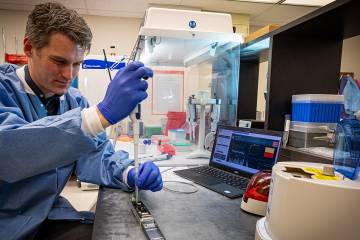Johns Hopkins has played a critical role in helping policymakers around the world respond to the coronavirus pandemic. To help manage the deluge of requests, the university has established the Modeling and Policy Hub, which coordinates experts from across Johns Hopkins divisions to supply decision-makers around the world with the best research and models.
"When we launched the Modeling and Policy Hub, we were focused on how to best address the growing pandemic given its strengths in this arena. The existing research groups with the infectious disease modeling and policy expertise were completely overloaded—new potential clients every day, working 16-hour days, seven days a week. We wanted to create some bandwidth for groups that were very actively advising decision-making and engage a growing list of faculty looking to bring their expertise to address emerging issues," says Daniel Polsky, a prominent health economist who helps lead the Modeling and Policy Hub. Polsky is a Bloomberg Distinguished Professor with appointments in the Carey Business School and the Bloomberg School of Public Health.
The Modeling and Policy Hub serves as a central intake office for requests that come in from both modelers within Johns Hopkins and external decision-makers involved in the COVID-19 response around the world. The requests are then assessed to connect the right people to the right resources and collaborators across university divisions. The group has more than 150 members who have informed critical decision-making and contributed to a briefing to staff members of the U.S. House of Representatives Energy and Commerce Committee.
The Modeling and Policy Hub was established as part of an effort to ramp up coronavirus-related university research, overseen by Denis Wirtz, the vice provost for research at Johns Hopkins, and his team.
"In a short time, the Modeling and Policy Hub has emerged as a critical effort, streamlining the collaborations between decision-makers and leading Hopkins scientists," Wirtz says. "The Hub is helping build a network of resources for the global community, providing better services to our government and NGO partners, and ensuring the response to COVID-19 around the world is based on the best available data and the best practices. We're very proud of their work."
For more information about the Modeling and Policy Hub's work, the Hub reached out to Polsky for a wide-ranging discussion about the insights that models can provide.
In the media, economic models and infectious disease models have been cast as sort of a zero-sum equation—gains in one mean losses in another. Do you think that's the case?
No, I don't think that is the case. It is true that there is a public framing that one can approach the pandemic by prioritizing economics or public health, but these approaches generate only subtle differences in optimal policies addressing the pandemic. At the risk of oversimplification, a model with disease transmission as an outcome might be characterized as an infectious disease model and a model with economic losses as an outcome might be characterized as an economic model. While the outcome variable might be different, reducing transmission is a central objective.
Of course, reducing transmission has potential short-term economic outcomes that are negative, but reducing transmission is critical to ultimately returning to positive economic outcomes. That being said, more holistic modeling approaches could better inform policy and policy communication.
Are these models able to predict how the pandemic will unfold?
Modeling is a way to condense a lot of evidence into a digestible form to inform decisions. There are many types of models built for a number of different purposes. The models of the infectious disease dynamics group at Hopkins, for example, stay away from making predictions or forecasts. Their models provide policymakers with information about the relative difference of what might happen in the future under alternative policy scenarios. They are not in the business of forecasting or predicting as it distracts from the priority of making informed decisions. Other models do offer predictions, but these predictions come with uncertainty tied to data inputs, policy, and behavior.
Understanding the value of modeling can be confusing given the variety of models out there and the limitations associated with different models. Through the confusion, keep in mind that models can provide valuable insights that would be impossible to grasp without the tool that modeling provides.
You plan to incorporate ethicists into the efforts of the Modeling and Policy Hub. Why?
The difficult policy decisions tied to addressing the pandemic involve challenging choices between who might receive lifesaving treatment to when is the right time to soften social distancing restrictions. This is not a decision that any discipline, whether it's economics or epidemiology, can make alone. It's an ethical question, when you enter into the world of trading off economic good for lives lost.
Of course, when you get up in the morning and get in the car and drive to work, you're taking a risk. You're risking that the economic benefit of going to work is worth the risk of getting hit by a car on your way to work. It's a risk that you take to leave the house where the life risked is most likely your own. But in the case of infectious diseases, by you leaving the house, you potentially put all your neighbors at risk. In addition to your own life, it actually might harm others, particularly those that have more health vulnerabilities. That's an added complication in terms of how you handle this trade-off between economic benefit and potential for loss of life.









